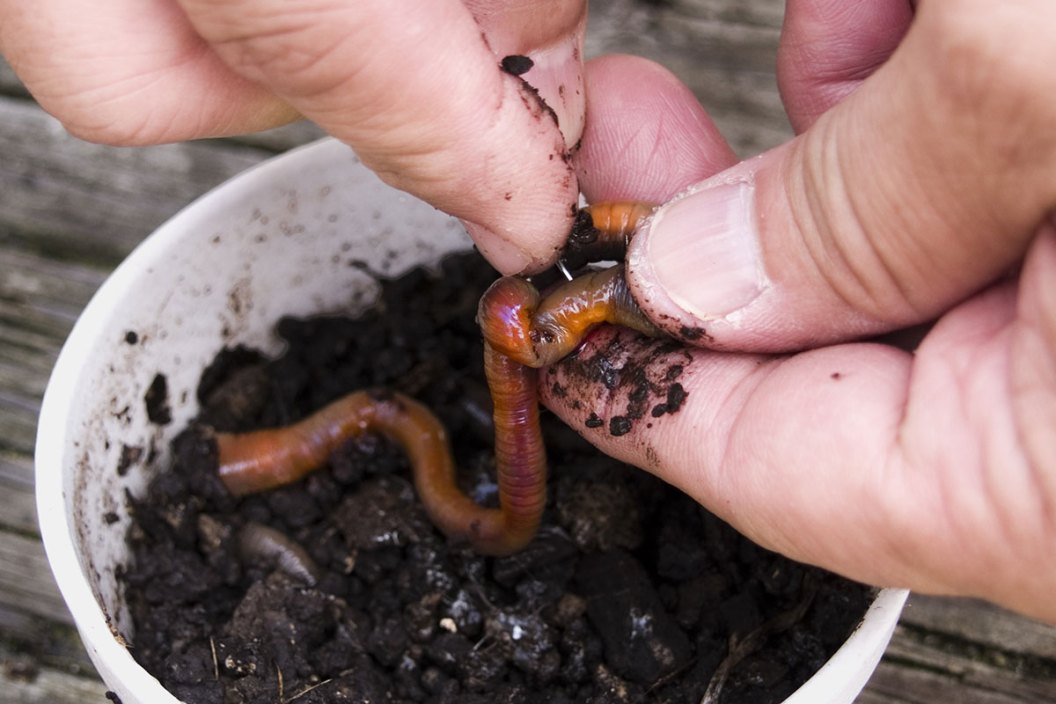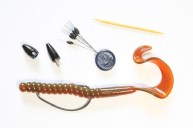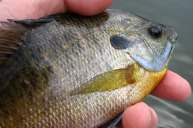There may not be anything better than fishing with worms, the go-to bait for anglers almost everywhere.
Remember when we were kids, and we threw those first fishing worms off of the dock to see what would happen? Whether it was a dozen bluegills fighting over it, or a big 'ol largemouth bass inhaling it, that's what fishing is all about!
We can discuss live bait like nightcrawlers or artificial soft plastic worms, but those wiggly, colorful, slimy little invertebrates just seem to catch fish. We all know it, and even the fish sort of know it, but they still get fooled.
If you really think about it, the worm is an iconic fishing bait. My earliest memory goes back to the Tom Sawyer and Huckleberry Finn days, reading stories of boys trying to catch the biggest catfish in the Mississippi River with a cane pole, a worm, and a dream.
Fishing worms as a primary game fish bait has been the leading tactic for generations. You can get super sophisticated and rig up a series of weights, hooks, soft plastic worms and fishing line. Or you can just stab a hook through the middle of a worm and wrap it around the shank a few times. They'll always manage to catch fish if the conditions are right.
It's like a gateway drug that hooks us on fishing forever (pun intended!), and they become the go-to for introducing other newbies to the sport, including our own kids. And as long as you have a brain in your head and a heart in your chest, fishing with your kids can lead to some of the most fun times we ever had, as a parent and an angler.
But what's funny is that there's no real consensus, among scientists or experienced anglers, as to why such a variety of fish species seem to be attracted to worms. It could be the smell, the shape, the similarity to their natural aquatic foods, or something different altogether. No one really knows, they just know they work well.
Despite the unknown reasoning, anglers from all over the United States—all over the world for that matter—seem to always be looking for the best way to find, procure, imitate, rig, and manipulate worms. To a certain extent, this is what they found.
Nightcrawlers
Nightcrawlers have stolen the show as the quintessential fishing worm, and they can be found in bait shops across the nation and beyond. They are readily accessible, easy to farm, and can be cut to the desired length and still remain lively enough to attract a little attention underwater.
There's a rule of thumb that says nightcrawlers and red worms may both be commonly called earthworms since, well, they dwell in the earth. European nightcrawlers are fast becoming a favorite breed for the worm farms everywhere, while red worms (also called red wigglers) have many properties that make them ideal as composting worms, their other main occupation.
According to Worm Facts, "The red worm's voracious appetite makes it the champion of the compost bin and a virtual worm casting (a.k.a. worm poop) machines. Red worms are fairly small, generally getting no larger than 5 inches."
As far as the European nightcrawlers go, they can get much larger than red worms, upwards of 7 inches long and as thick as a pencil. Canadian nightcrawlers, which are understandably quite hardy and sizable, can be bought through the mail.
Nightcrawlers can be used to catch nearly every freshwater fish in North America, and will even see occasional success with saltwater fishing. They generally aren't very expensive, even though they represent a sizable industry.
Buying worms is all well and good, and worm farms have their place, but if we can go outside in the summertime after a rain and fill a coffee can in no time, we will. Finding and collecting your own is even less costly, and it an actually be kind of fun!
How to Catch Nightcrawlers
Folks have certainly found some interesting ways to catch them, including grunting!
Grunting uses a strategy of rubbing a flat piece of metal across the top surface of a longer piece of wood that's been hammered into the ground. Worms seem to either be annoyed by this or curious, we may never know.
Apparently the vibrations make them uncomfortable enough to come up to the surface to be caught. You can also conduct the same technique with two metal rods, a car battery, and jumper cables. Pound the rods into the ground, attach the jumper cables to the rods and the battery, and then allow the electricity to drive the worms out.
If you don't mind some suds in your yard, try a bucket of water and some earth friendly dish soap. Some folks say that the worms can't breathe in the sudsy water and have to come up for air. Others say hogwash, but it's worked for me and plenty of others before.
You can also try the old cardboard method, and let the worms come to you. Lay some in your yard and wet it with water. The next day, go out and lift the cardboard and you should find a few worms waiting for you. The more cardboard you spread, the more worms you should find.
Plastic Worms
Here's where the rubber hits the road for many serious anglers. When I first started using what were then "new-fangled contraptions," I was following the trends set by pros and the ads seen in magazines. The colors were exciting, they could reach various lengths, and they lasted through a lot more casts and retrieves than a live worm ever did.
We eventually saw brands like Mann's Jelly Worm and Mister Twister baits, some of which stretched 12 inches long! Back then, it seemed like the fish had never seen such a thing and would strike these synthetic worms like it was their last meal.
Modern soft plastic baits captured the attention of the angling consumer sometime in the mid to late 1960s, and things have never been the same since.
Today, we have Senko worms, drop shot worms, wacky worms, finesse worms, and even paddle tail worms at our disposal. The varieties that emerge haven't slowed much, either. Plastic baits, particularly plastic worms, are an essential tool for the serious bass fisherman, and can typically be seen in the tackle boxes of those targeting crappie, panfish, walleye, perch, trout, catfish, and more.
At this point, there are so many colors, sizes, and shapes it's almost impossible to choose from them all. Then, when they decided to impregnate them with scents, flavors, and other tastes, it added another element of choice. Some brands, like Berkley, argue that their combination of features will cause fish to hold on longer, giving them a better chance of getting securely hooked.
It's become serious business, and an even bigger industry than live worm farming, transforming the tackle section of outdoor stores forever.
Plastic Worm Rigs: A Quick Primer
There are plenty of ways to attach a soft plastic worm to a hook, and the results are often referred to as rigs. Some of these techniques have become so popular that artificial worms and terminal tackle are being designed and sold for use in specific rigs. There are often weights involved, which can help present the plastic worm so as to attract the most attention from fish.
We'll wrap things up with descriptions of a few of the most popular, and our own favorite, plastic worm rigs.
Let's start right off with maybe the world's number one: the inimitable Texas rig. This set up exemplifies simplicity itself and is used by sliding a tungsten bullet weight onto your line, tying your hook on (usually a good 4/0 hook is the standard), and then attaching a worm of your choice to the hook Texas style, with the point of the hook embedded inside of the plastic worm.
This becomes a bottom-dragged bait, as the sliding weight holds at the bottom and the hook and worm trails behind. The notion of embedding the majority of the hook inside the worm itself is believed to help with disguising the rig as well as position the hook's point in the ideal place to securely latch to the fish after a bite.
Now let's discuss the Carolina rig. The difference here is that with the Texas rig, the weight stays near to the head of the worm and holds it down in the cover, where the weight of the Carolina rig is tied further up the line above a swivel to hold it in place.
This will cause the weight to drag through the cover and the bait to wiggle around above it.
For Carolina rigs, the hook is dipped through the head of the worm just enough to hold it, then twisted around and into the body so that the hook point disappears into the flesh of the plastic.
If you haven't heard of the Ned rig, you should have by now. The Ned rig uses a mushroom head jig, anywhere from 1/16 to 1/8 ounces at the most.
On the jighead, anglers thread a small piece of plastic worm, usually between two and three inches, but no more. It sounds simplistic as heck, because it is.
Created by Ned Kehde, this midwestern finesse tactic is one that you might be thinking is too silly and simple to work, but the results say it works.
Lastly, the old school shaky head rig that has been around forever is the go-to bait for many veteran anglers when the chips are down and the bite is off. It's basically a 1/8 ounce jig head with a plastic worm dressing, but there's more to it than just that.
Because the tackle companies have become so advanced, you can really customize your jig presentation. Some companies offer a football head jig, while others a stand-up head. Finesse worms are a solid choice for this rig, along with paddle tails, Senkos, and straight tails. The choice is yours.
As fishing bait goes, the worm is the king of them all bar none. There are worm rigs made for walleye fishing, bass fishing, trout fishing, and especially for panfishing. New fishing lures hit the scene daily, but the good old worms seem to always work when attached to your hook.
Looking for a little more or even hot lunch for your hunting blind? Follow my webpage, or on Facebook and Twitter.
NEXT: WALLEYE: PROFILING THE TOOTHY FRESHWATER FAVORITE OF NORTH AMERICA
WATCH





